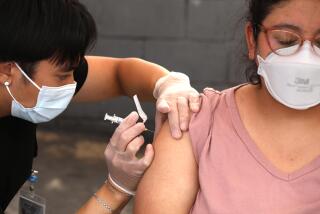My patients can ‘feel well’ yet test positive for the coronavirus. They’re shocked, but I’m not

- Share via
As a physician, I’m part of a COVID-19 task force that contacts coronavirus-positive patients and clarifies the next steps in their care. When I tell them their test result is positive, many react with puzzlement, saying they “feel fine.” So I was more than dismayed when the Centers for Disease Control and Prevention appeared to succumb to political pressure to change its COVID-19 guidelines and discourage testing of people who are asymptomatic.
When the CDC recently issued new guidelines that no longer recommend testing people who feel fine but have been in close contact with someone who has COVID-19, the medical community and politicians across the country sounded an alarm. More than one expert said the guidelines had been revised for political, rather than scientific, reasons.
And New York Gov. Andrew Cuomo squarely blamed politics because the Trump administration doesn’t “want publicity that there is a COVID problem.” He pointed out that “if you don’t test people for COVID, there are fewer cases” and called it a strategy of “denial.”
Cuomo’s criticism resonated with many physicians who, like me, repeatedly inform patients that “yes, you can look healthy, but still have the coronavirus and be spreading the infection.”
Here’s one chilling example of asymptomatic transmission from my outreach across Southern California that I have been given permission to share. A mother decided to have a small outdoor gathering with her adult son who lived with her and two other guests who did not — another son and a friend. The four people at the barbecue all felt well and masks were not worn. But within a few days, the mother gradually had difficulty breathing and was soon hospitalized with COVID-19.
She had been limiting her outings, and the son who lived with her studied remotely at home. She probably got the virus from either the visiting son or her friend. The mother had kept her social circle small, yet she was dead within two weeks of the barbecue.
Her story — dying from a virus she picked up from someone who was feeling well — is far from unique. On its website, the CDC has a table that shows about 50% of COVID-19 infections are spread by people who have no symptoms — so the political push to decrease testing naturally baffles physicians.
COVID-19 is regularly spread by people without symptoms, and catching these silent spreaders is critical to controlling COVID-19. This mother’s story should serve as a cautionary tale to those who have become complacent about going out in public or socializing at home. Her story emphasizes why we need more coronavirus testing, not less.
Many of my patients who “feel well” were tested because of a work requirement. “Someone at work was found to have COVID-19,” they will say, and “now we all have to get tested.” Very few could identify the COVID-19-positive individual who transmitted the virus to them, let alone recall anyone at work who appeared to be sick.
When their test returns positive, they are shocked. But I am not. These presymptomatic or asymptomatic transmissions are old news at my clinic. Deciding against testing those who “feel fine” is an easy way to help the virus roar out of control, spreading uncaught and out of sight.
My clinical observations are supported by a large body of peer-reviewed, scientific literature. The now-famous Diamond Princess cruise ship’s COVID-19 outbreak from earlier this year was a rare glimpse of the virus in an enclosed area. Although the majority of people initially felt fine, the virus rapidly spread, infecting about 700 people on the ship. About 58% of those with confirmed COVID-19 infections had zero symptoms at the time of testing, according to a letter recently published in the science journal the New England Journal of Medicine.
Symptoms are not a reliable marker of infection or infectivity — and they should not be a deciding factor in any decision to test.
Adm. Brett Giroir, the assistant secretary for health who spearheads the coronavirus testing efforts for the Trump administration, said the new recommendations emphasize testing “individuals (who may be asymptomatic) when prioritized by public health officials.” What he is implying is: “We’re punting on giving comprehensive testing guidance, and individual health professionals should figure it out on their own.” That may sound innocent enough, but scattering the decision-making among individual voices divides the movement for COVID control. Dividing and splintering rarely results in cohesive success.
The solemn Hippocratic oath that physicians take says, “first, do no harm.” This calls for a laser focus on a patient’s health and science, not politics. The science is clear. Asymptomatic spread of COVID-19 is rampant.
Identifying the innocent, hidden spreaders of this preventable, deadly Russian roulette-like disease is critical to controlling the spread of COVID-19 — and requires a unified national public health approach.
Zainab Saadi of Irvine is an internal medicine physician and a member of a task force of health professionals who care for COVID-19-positive patients.
More to Read
A cure for the common opinion
Get thought-provoking perspectives with our weekly newsletter.
You may occasionally receive promotional content from the Los Angeles Times.









